If you're reading this, it's likely that you're considering Account-Based Marketing (ABM) for your company.
You've heard about its potential benefits, seen its popularity rise, and now you're wondering:
Is ABM the right choice for us?
It's a crucial question, one that merits a thorough investigation. And that's exactly what we're going to do in this article!
Consider this an expert consultation. We'll review the basics of ABM, explain its advantages, who it is best for, and discuss whether it's the right move for your company.
On top of that, we'll also guide you through a step-by-step ABM workflow to help you effectively launch your strategy.
You can also watch the 8-minute video version - I covered all the below topics in my presentation at the "ABM Tactics for Large Accounts" meet-up in Tel Aviv.
Why do you need account-based marketing?
When it comes to traditional marketing strategies like SEO, SEM, display, and social, there's one common limitation - control.
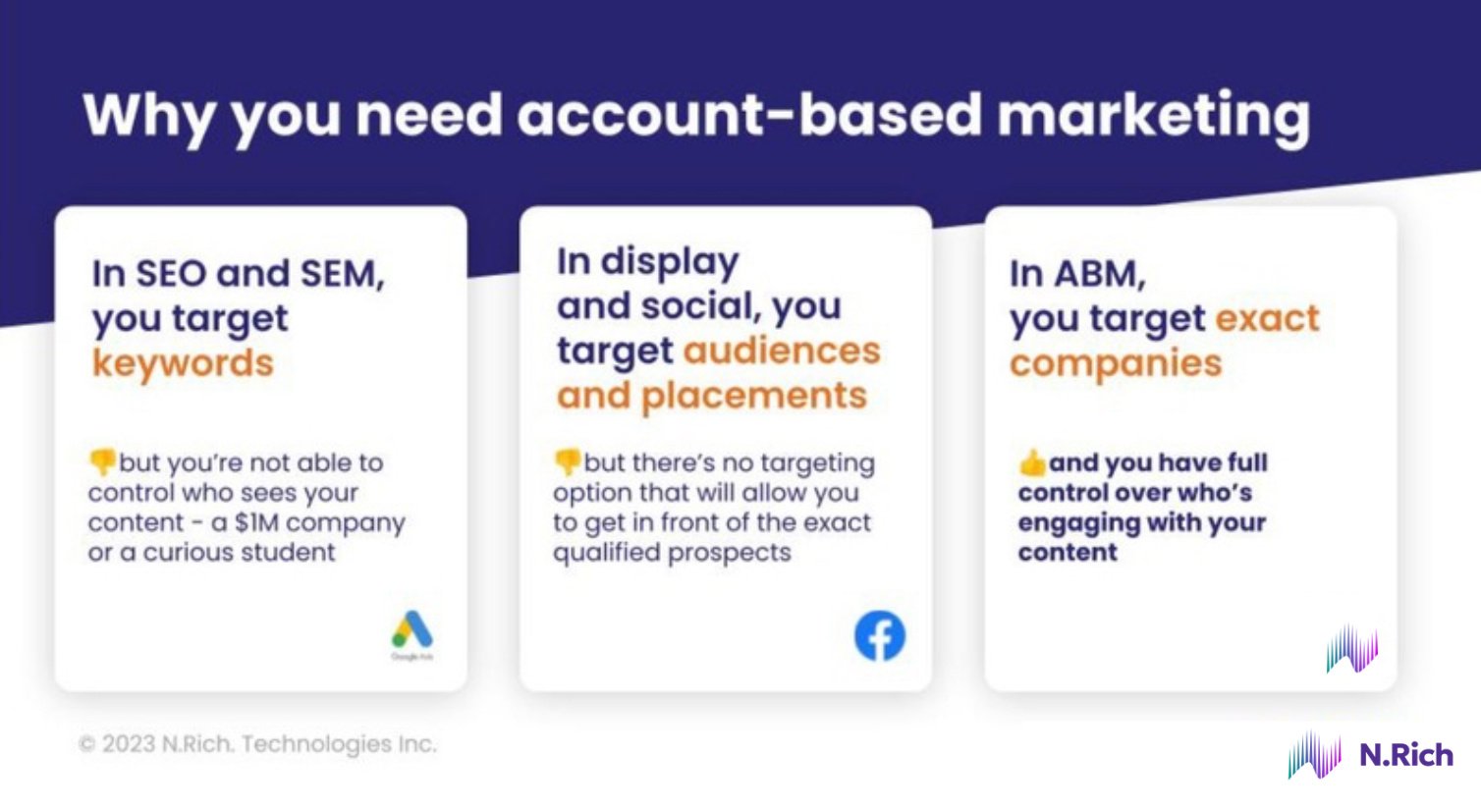
In SEO and SEM, you optimize for keywords, but there's no way to ensure who will engage with your content - it could be a million-dollar company seeking your services, or it could be a curious student conducting research.
While the latter isn't necessarily a bad thing, it doesn't necessarily translate to business growth.
In display and social media marketing, you can target audiences and placements, but there's still a missing piece of the puzzle.
You might be getting your content in front of a large audience, but there's no guarantee that your qualified prospects are included in that crowd.
This is where Account-Based Marketing (ABM) takes the spotlight.
ABM allows you to take the reins and target specific companies that align with your ideal customer profile.
But is it right for your company?
Is ABM a good fit for your company?
As compelling as the benefits of Account-Based Marketing (ABM) may be, it's crucial to understand that it's not a one-size-fits-all solution.
The real question is, is ABM the right fit for your company?
Here are a few scenarios where implementing an ABM strategy might be worth it:
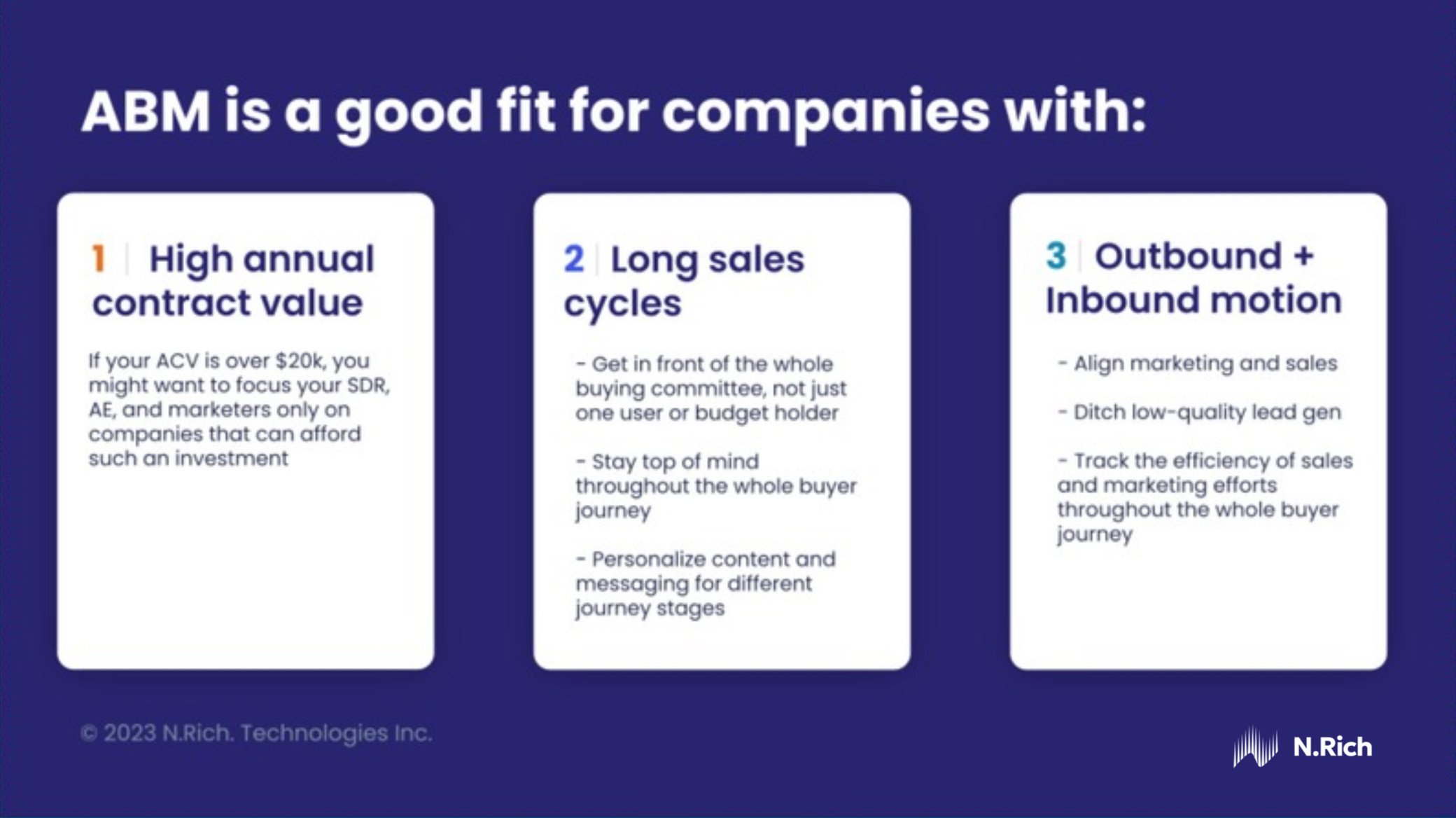
1. High Annual Contract Value (ACV)
ABM shines brightest when the stakes are high.
If your business operates with a high Annual Contract Value — say, over $20,000 — an ABM strategy might be just the ticket.
Because in such cases, the decision-making process is often more complex, the buyer journey longer, and the number of stakeholders larger.
In such circumstances, a 'spray and pray' marketing approach might result in wasted resources, with a lot of time and effort spent on leads that are unlikely to convert, simply because they don't have the required budget.
With ABM, your Sales Development Representatives (SDRs), Account Executives (AEs), and marketing team can focus their efforts on the right accounts - those that can afford and are likely to make such a significant investment.
2. Long Sales Cycles
Another key indicator that ABM might be right for you is if your company has a typically long sales cycle.
The longer the cycle, the more opportunities for potential clients to lose interest, forget your messaging, or be wooed by competitors.
In these cases, ABM can be your best strategy.
With its ability to engage the entire buying committee, not just a single user or budget holder, ABM ensures that your message resonates at every level of the organization.
What's more, by staying top of mind throughout the entire buyer journey and tailoring content to the specific needs of each account at different stages of their journey, ABM can effectively nurture these high-value leads from initial interest to final sale.
3. Outbound + Inbound Motion
Lastly, if your revenue strategy involves a combination of outbound and inbound methods, ABM can be the glue that binds these efforts together.
Traditional lead gen can often result in a flood of low-quality leads that can drain resources and demoralize sales teams.
ABM, on the other hand, helps you to zero in on high-quality leads that are more likely to convert.
By aligning marketing and sales around a select group of target accounts, ABM can help to streamline your efforts, ensuring that everyone is pulling in the same direction.
Plus, ABM's focus on tracking and measurement allows you to monitor the effectiveness of your strategies throughout the entire buyer journey, offering actionable insights that can help you continuously refine your approach.
There's more than M in ABM
While the 'M' in Account-Based Marketing may stand for 'marketing,' the truth is, ABM extends far beyond just marketing initiatives.
 When deployed effectively, ABM has the potential to impact various facets of your organization, from sales and customer success to operations and product development.
When deployed effectively, ABM has the potential to impact various facets of your organization, from sales and customer success to operations and product development.
Let's delve into how ABM can amplify the efforts of these different departments.
1. Sales
ABM can act as a catalyst for sales teams, especially in terms of account prioritization and nurturing.
By aligning marketing and sales efforts around high-value accounts, ABM ensures that sales teams are spending their time and resources on the most promising leads.
Additionally, ABM allows for the creation of personalized engagement strategies, fostering deeper connections with prospects and accelerating the sales process.
2. Sales Development Representatives (SDR)
For SDRs, ABM can provide a clear roadmap for engagement.
By identifying and prioritizing high-value accounts, SDRs can tailor their outreach efforts to be more relevant and engaging, effectively warming up leads before they enter the sales pipeline.
Whether it's pre-sales nurturing or ongoing engagement, ABM can help SDRs make every interaction count.
3. Customer Success
ABM doesn't stop once a deal is closed.
In fact, it can play a significant role in driving customer success and reducing churn.
By continuing to deliver personalized experiences post-sale, ABM can strengthen customer relationships and ensure ongoing success.
Additionally, the insights gathered through ABM can help identify potential churn risks early, allowing customer success teams to proactively address them.
4. Operations
When it comes to operations, ABM can facilitate better alignment between sales and marketing by creating unified scoring models leading to both departments working from the same playbook.
This can massively reduce friction and increase efficiency which would lead to a lot more effective resource allocations and improved ROI.
5. Product
ABM can also be a valuable tool for product teams. By focusing on high-value accounts, product teams can gain a better understanding of the needs and preferences of their most important customers.
This can guide feature prioritization and targeted product launches, ensuring that the product evolves in a way that aligns with the needs of key accounts.
6. PR & Communications
Even the PR and communications team can benefit from ABM.
By focusing on high-value accounts, they can uncover more relevant partnership, event, and PR opportunities.
This not only enhances the company's reputation but also ensures that PR efforts are aligned with the company's strategic goals.
In essence, ABM is not just a marketing strategy - it's a company-wide approach that can drive success across departments.
It's about aligning all facets of your organization around the goal of engaging and delighting high-value accounts, fostering deeper relationships, and driving sustainable growth.
So, while 'M' may stand for 'marketing,' in ABM, it's really about so much more.
Now that we've seen the broad applications of ABM across your organization, let's look at how to get an ABM strategy off the ground with a step-by-step workflow for an ABM pilot.
ABM Pilot: Step-By-Step Workflow
So, you're convinced that ABM is the right strategy for your company, but where do you start?
Here, we'll walk you through a step-by-step workflow to launch an ABM pilot, helping you take the leap from theory to practice.
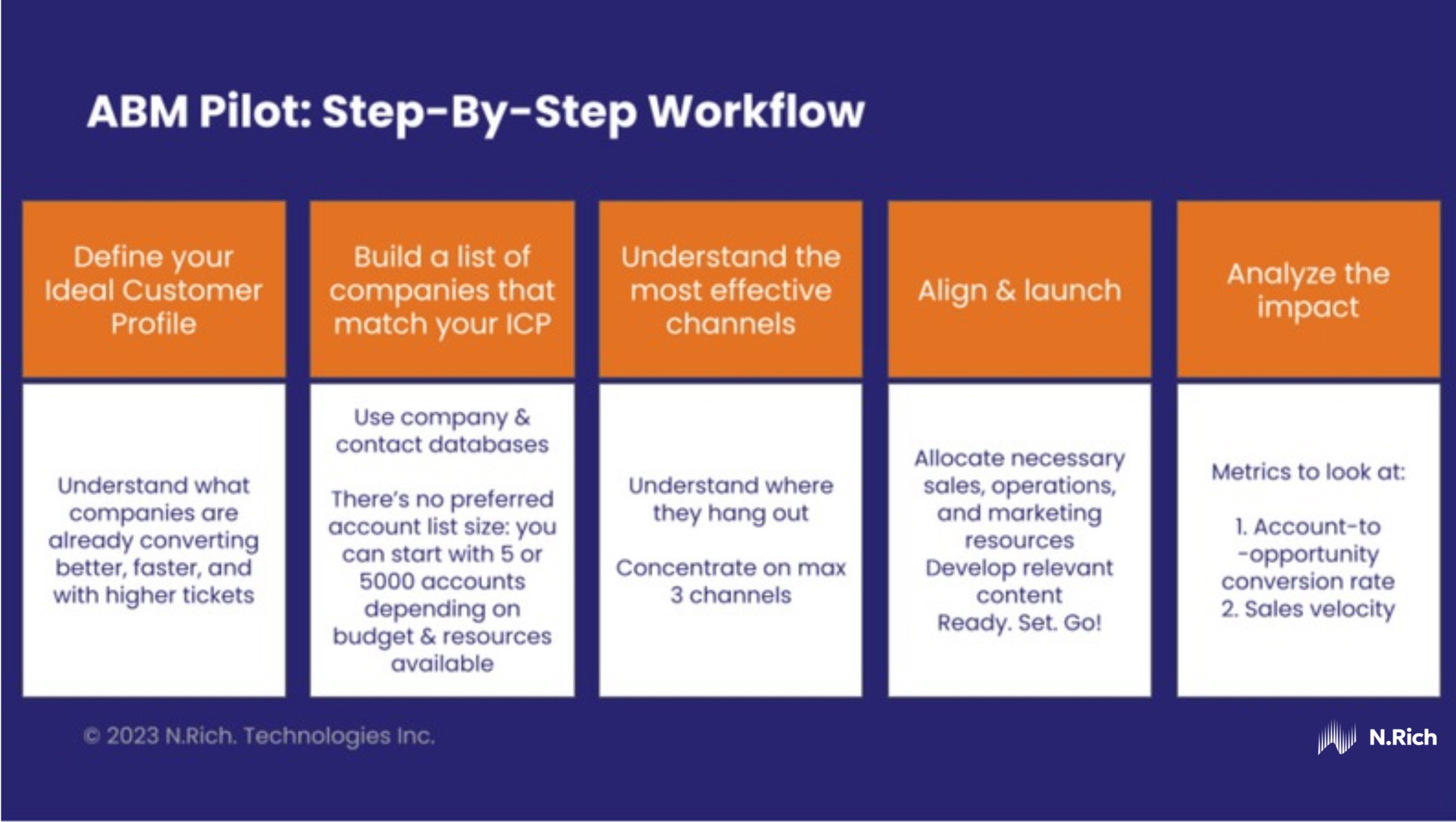
Remember, the goal of this pilot is to validate the effectiveness of ABM for your organization and to gather learnings that can inform a larger rollout.
Let's get started with the first step:
1. Define your Ideal Customer Profile
Your Ideal Customer Profile (ICP) is a hypothetical description of the company that would get the most value from your product or service, and would also provide significant value to your company.
This step is crucial because it forms the foundation for your ABM strategy. It's not just about who you want to sell to, but who will derive the most benefit from your offering and, in turn, provide the most value to you in terms of revenue, loyalty, and advocacy.
Understanding your ICP involves looking at which companies are already converting better, faster, and with higher ticket values. By analyzing your existing customer base and identifying common traits among your best customers, you can begin to develop a detailed and actionable ICP.
Remember, the more specific you are with your ICP, the better you'll be able to tailor your ABM efforts to attract similar companies.
Now defining your ICP isn't a matter of guesswork or assumptions, it requires a systematic approach. Here's how you can go about it:
- Analyze your best customers
- Identify their key characteristics - what do they have in common?
- Draft and validate your ICP with the other teams (marketing, sales, and operations)
- Update you ICP characteristics quarterly
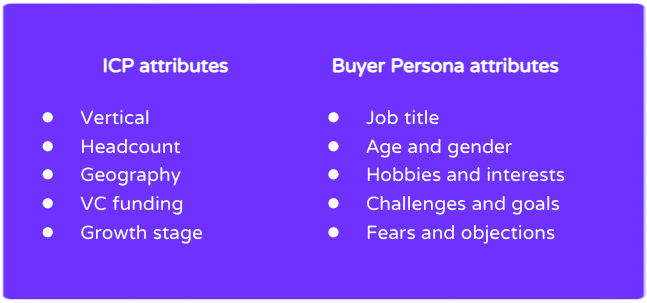
How N.Rich can help:
You can automatically assess if your ICP is valid by tracking your CRM deals and calculating their sales velocity. All the accounts you can find on N.Rich are going to have Sales Velocity rating (Low, Medium, High) and you can find it under analytics details of your Sales Velocity ICP accounts:
-
Various metrics of your opportunity data comparing ICP to non ICP
-
Sales Velocity metrics of ICP compared to non-ICP accounts
-
The firmographic profile of the ICP accounts
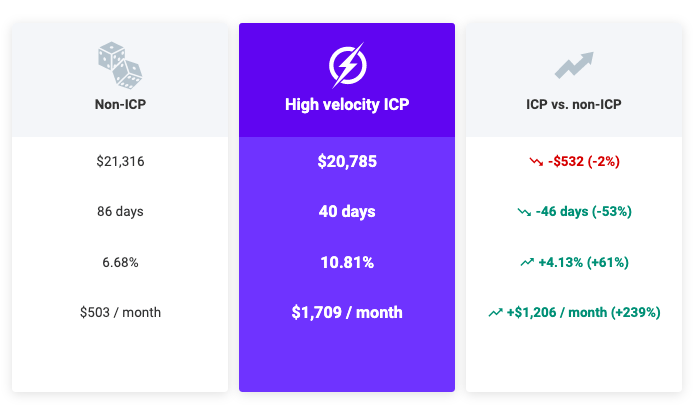
2. Build a List of Companies that Match Your ICP
Once you have a clear idea of your Ideal Customer Profile, the next step is to compile a list of companies that match this profile. These will be the accounts you focus on in your ABM strategy.
Creating this list involves using various company and contact databases. Leveraging these resources allows you to identify companies that check all the boxes in terms of your ICP attributes.
Keep in mind that there's no definitive 'right' size for your account list.
Depending on your resources and budget, you may choose to start small with just a handful (5) of accounts or go big with thousands (5000).
The key is to choose a number that is manageable for your team and allows you to provide the high level of personalization that ABM requires.
Here are some steps to guide you in building your account list:
Use Company and Contact Databases
Begin by scouring databases such as LinkedIn, Crunchbase, or other industry-specific databases.
These platforms contain a wealth of information about companies, including their industry, size, location, and more.
They can be a valuable resource for identifying companies that align with your ICP characteristics.
Leverage Existing CRM Data
Don't overlook the data you already have. Your Customer Relationship Management (CRM) system likely holds plenty of valuable information.
Review your existing leads and contacts to uncover companies that fit your ICP but might not have been prioritized in the past.
Also, consider looking at customers who almost converted but didn't — they might offer insight into potential high-value target accounts.
Consider Third-Party Data Providers
Third-party data providers can offer a rich source of information about potential accounts. These providers can help you identify companies that meet your ICP criteria and provide additional insights that may not be readily available elsewhere.
This could include details on a company's technology stack, recent funding rounds, growth indicators, and more, which can be invaluable in your ABM strategy.
Engage Sales Team Insights
Your sales team is on the front lines, engaging with customers and prospects daily.
They likely have a deep understanding of the types of companies that make the best customers. Engage with them to get their insights and input on potential target accounts.
They may have firsthand knowledge of accounts that have shown interest in your offerings or have an unmet need that your solution could fill.
Apply Predictive Analytics
If you have access to predictive analytics tools, these can be incredibly helpful in identifying companies that match your ICP. These tools use machine learning algorithms, AI, data analysis and statistical models to analyze a variety of data points and predict which companies are most likely to convert.
Remember, building your account list is a crucial step in your ABM journey and it's all about quality.
It's much better to have a smaller list of companies that perfectly match your ICP than a larger list of loosely matching companies.
How N.Rich can help:
N.Rich helps you generate your TAL by leveraging firmographic data such as company size, industry, and location, alongside technographic parameters like the technology stack a company uses. This ensures that the accounts in your lists are a perfect match for your ICP. These accounts are then automatically scored based on their ICP fit, using real-time CRM data to provide an accurate, data-backed evaluation. This will help your sales and marketing teams are focused on the accounts most likely to convert, maximizing both efficiency and results.


3. Understand the Most Effective Channels
Once you've compiled your target account list, it's time to consider the best ways to reach these companies.
Not all marketing channels are created equal, and what works for one target account may not work for another.
That's why it's critical to understand the most effective channels for your particular audience.
This involves not only understanding where your audience "hangs out," but also where they're most receptive to your messages.
Here's a step-by-step process for identifying the most effective channels for your ABM strategy:
Review Past Interactions
Start by reviewing past interactions with your target accounts.
Which channels have they responded to in the past?
These might include email, social media, content marketing, events, or others.
If a particular channel has proven effective previously, it's likely a good starting point for your ABM strategy.
Research Your Audience
Understanding where your target accounts spend their time is crucial.
If they're active on LinkedIn, for example, then focusing on this platform makes sense.
If they regularly attend industry events, then these could be excellent opportunities for face-to-face engagement.
Conduct thorough research to understand your audience's habits and preferences.
Leverage Industry Insights
Industry reports and surveys can provide valuable insights into effective channels for your target audience. These reports can show trends in channel effectiveness and preferences that can inform your strategy.
Test and Learn
As with any marketing strategy, testing is crucial.
You might start by focusing on a few potential channels, then closely monitor performance to see which are most effective.
Over time, you can adjust your strategy based on these findings.
As a rule of thumb, it's best to concentrate on a maximum of three channels to start with.
Spreading your efforts too thinly across multiple channels can dilute your message and make it difficult to measure effectiveness.
Once you've nailed down the most effective channels, you can move on to aligning and launching your ABM strategy.
How N.Rich can help:
N.Rich helps businesses quickly identify ICP vs. non-ICP traffic across channels. The platform shows which sources drive more ICP traffic, enabling smarter optimization and improved targeting.
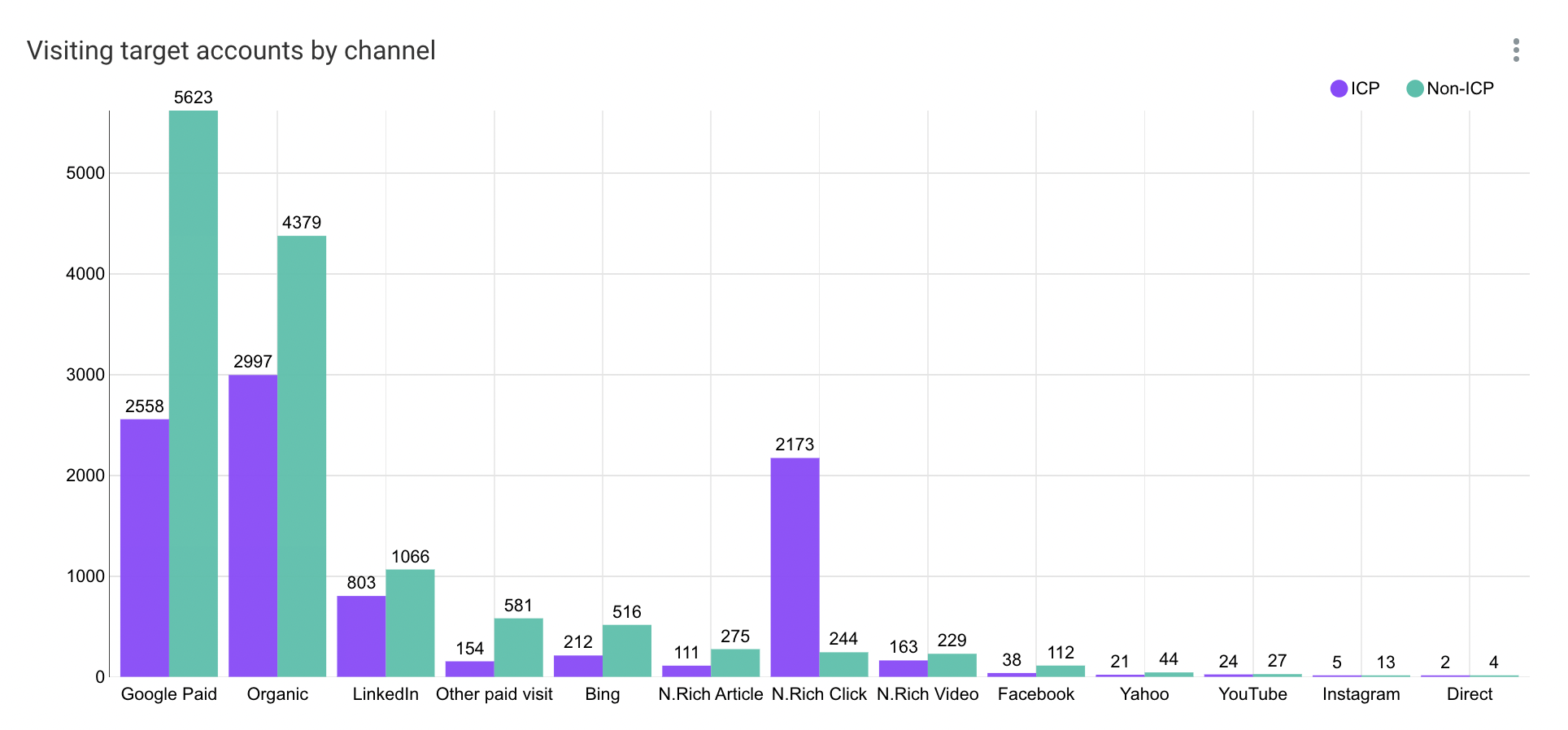
4. Align & Launch
Having your Ideal Customer Profile (ICP), a well-curated list of companies that match your ICP, and a clear understanding of the most effective channels, you're now prepared to align your resources and launch your Account-Based Marketing (ABM) pilot.
This stage necessitates strategic planning, cross-departmental collaboration, and the development of personalized, impactful content.
Here is a detailed look into how you can launch your ABM pilot effectively:
Align Sales and Marketing Teams
Make sure that everyone understands the goals and objectives of your ABM strategy, their respective roles, and the metrics that will be used to evaluate success.
Regular team meetings, collaborative planning sessions, and shared dashboards can help foster this alignment.
The aim is to create a unified customer journey that combines the strengths of both departments.
Allocate Necessary Resources
Implementing an ABM strategy is not a small task.
It requires substantial resources, both in terms of manpower and budget.
Assess your current resources to ensure that you have adequate team members, tools, and budget allocated to execute your ABM strategy effectively. This might require shifting resources from less strategic areas or potentially securing additional budgets.
The key is to ensure your ABM strategy is not resource-starved.
Develop Personalized and Relevant Content
Content is at the heart of ABM.
But it's not just any content - it's content that's deeply personalized and highly relevant to each target account.
This could range from tailored email communications to custom-made white papers and articles addressing industry-specific challenges.
The objective is to provide value, position your brand as a thought leader, and build meaningful relationships with your target accounts.
Set Up Targeted Campaigns
Once you've developed your personalized content, you need to structure your targeted campaigns.
This involves using your understanding of the most effective channels to deliver tailored messages to your target accounts. It also includes setting up robust tracking mechanisms to measure engagement and effectiveness.
Each campaign should be designed with the goal of nurturing relationships and moving accounts further down the sales funnel.
Launch and Monitor
With everything set, it's time to hit the launch button.
But remember, ABM is not a one-and-done deal.
It's an ongoing process that requires continuous monitoring and optimization.
Post-launch, you need to keep a close eye on your campaigns to understand what's working and what's not.
Iterate and Improve
Post-launch, use the data collected to refine your strategy.
This could mean adjusting your ICP, refining your account list, testing different channels, or personalizing your content further.
With ABM, there is always room to test and optimize.
Engage in an iterative cycle of improvement to ensure your strategy continues to deliver results. (more on this in a second)
Remember, the success of your ABM strategy hinges on the alignment of your sales and marketing teams, the resources you allocate, and the relevance of your content.
How N.Rich can help:
N.Rich enables you to run cross-channel campaigns targeting only your ICP using various formats like banners, articles, and videos. The platform ensures that these ads are displayed across multiple channels, exclusively reaching your ICP accounts to maximize relevance and engagement. This multi-touchpoint approach ensures visibility in different areas, delivering the right content when it’s needed most.
5. Analyze the Impact
Upon launching your Account-Based Marketing (ABM) pilot, the next crucial step is to thoroughly analyze the impact of your efforts. An ABM platform can help you with this analysis..
Here are the metrics to track if you want to assess your ABM success:
- ICP ad and organic engagement
- Account-to-opportunity conversion rate
- Sales velocity
- Revenue metrics: ROI (on revenue and on pipeline) and CAC
Here's a timeline and the metrics to monitor at every stage of your ABM pilot:
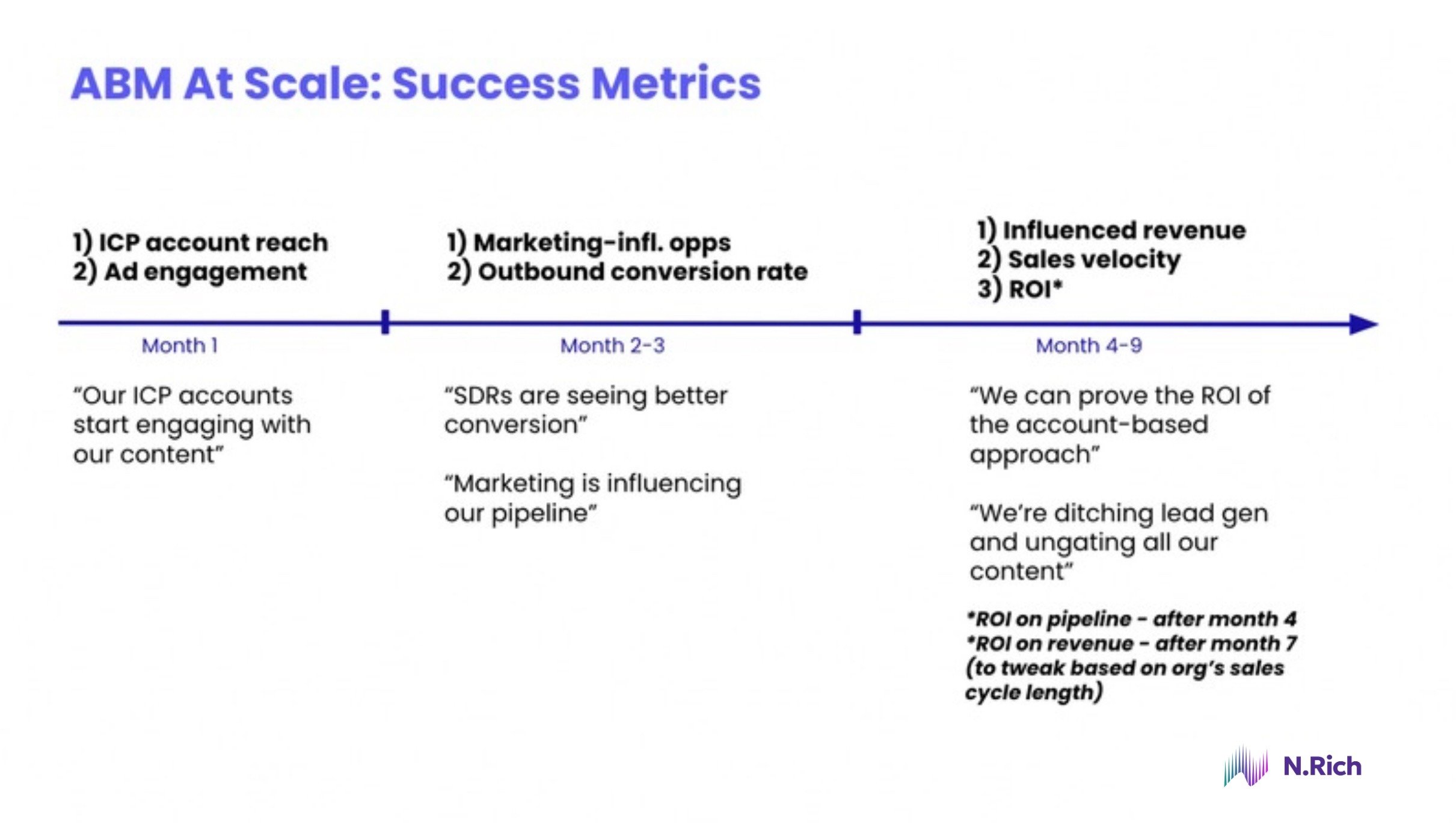
How N.Rich can help:
N.Rich lets you track ABM influence on specific accounts by monitoring engagement across multiple stages, providing a holistic view of how ABM impacts your pipeline and revenue—insights not available in tools like Google Analytics.
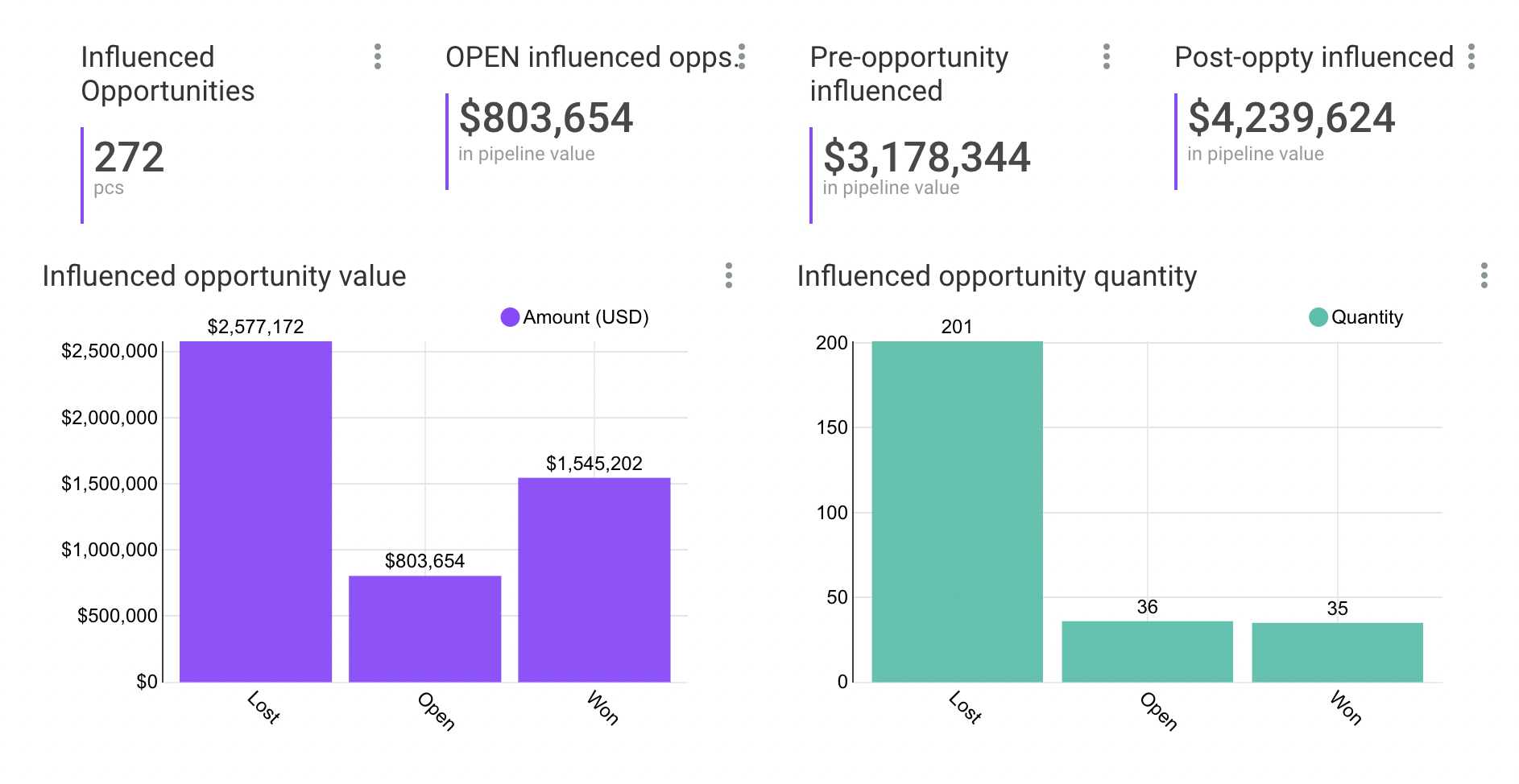
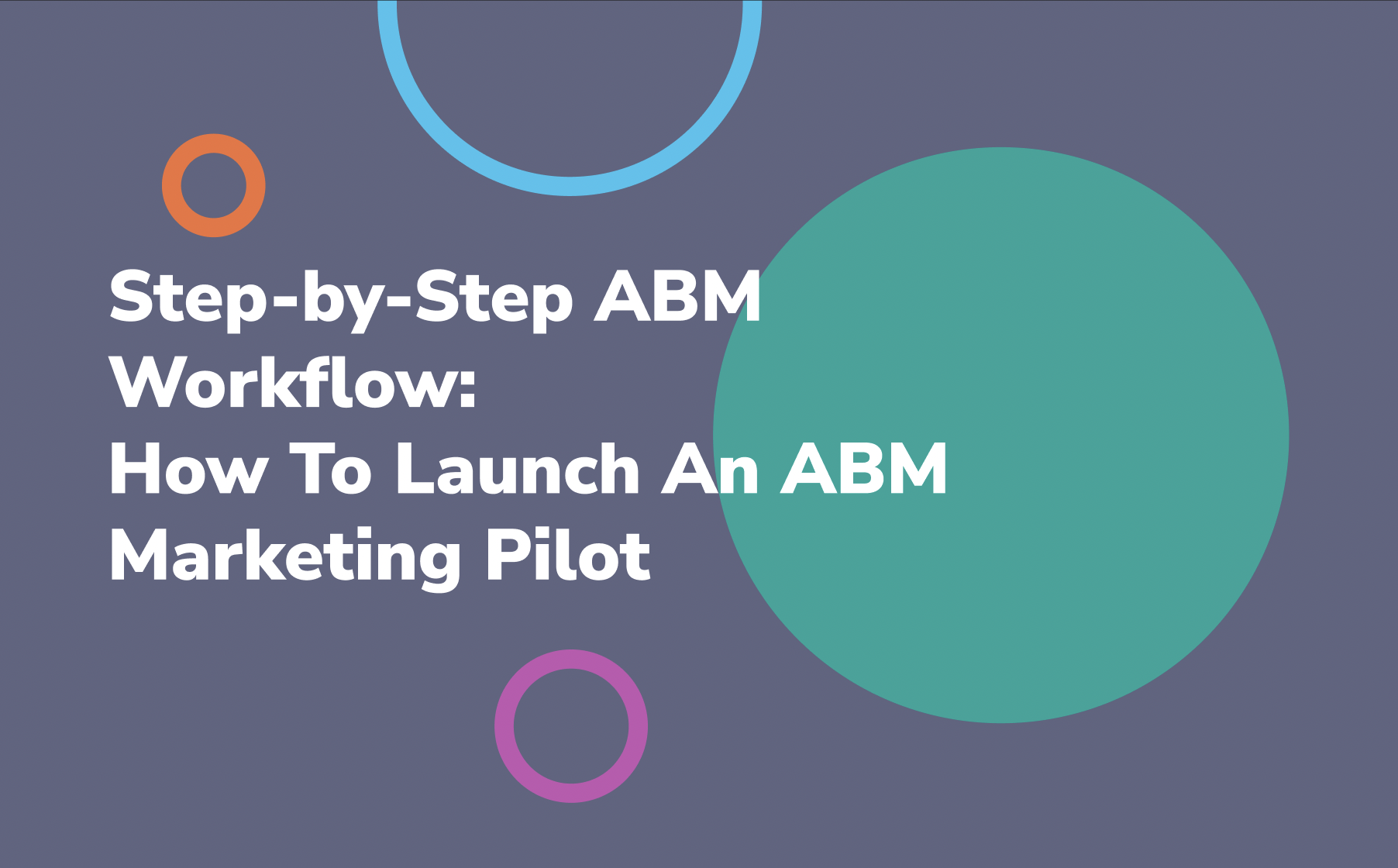



 When deployed effectively, ABM has the potential to impact various facets of your organization, from sales and customer success to operations and product development.
When deployed effectively, ABM has the potential to impact various facets of your organization, from sales and customer success to operations and product development. 









.webp)